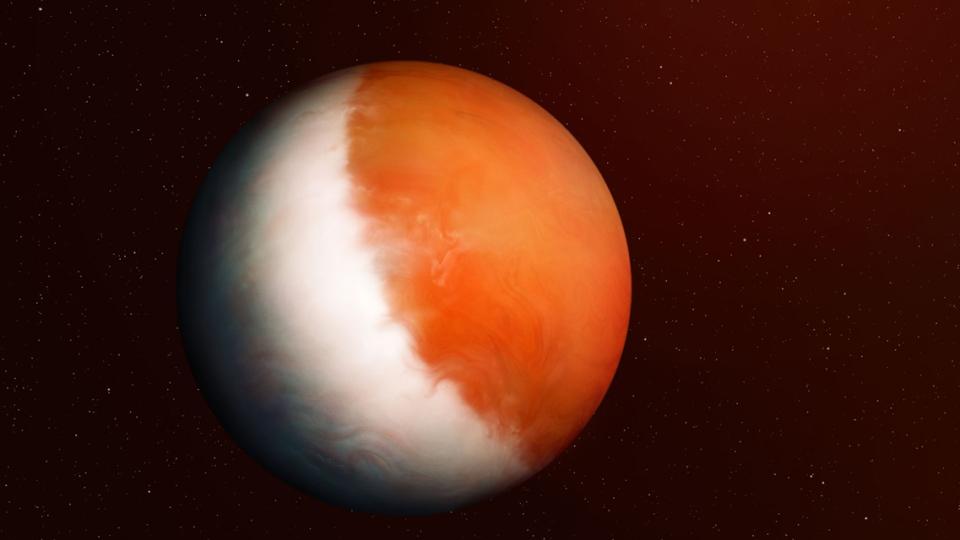Exeter Fellow studies rare planet using James Webb Space Telescope
A team of international researchers including Exeter College Supernumerary Fellow, Dr Jake Taylor (Glasstone Fellow in the Department of Physics), has used the James Webb Space Telescope (JWST) to explore the exotic atmosphere of LTT 9779 b, a rare ‘ultra-hot Neptune’. The results have been published this week in Nature Astronomy.
The study offers new insights into the extreme weather patterns and atmospheric properties of this fascinating exoplanet, LTT 9779 b, that resides in the so-called hot Neptune desert, a category of planets where exceptionally few are known to exist. While giant planets orbiting very close to their host stars – often called hot Jupiters – are commonly detected using current exoplanet-finding methods, ultra-hot Neptunes like LTT 9779 b remain remarkably rare.
‘Finding a planet of this size so close to its host star is like finding a snowball that hasn’t melted in a fire,’ says graduate student Louis-Philippe Coulombe from the Université de Montréal’s Trottier Institute for Research on Exoplanets (IREx) who led the study. ‘It’s a testament to the diversity of planetary systems and offers a window into how planets evolve under extreme conditions.’
A unique laboratory for alien weather
Orbiting its host star in less than a day, LTT 9779 b is subjected to searing temperatures reaching almost 2,000°C on its dayside. The planet is tidally locked (similar to Earth’s Moon), meaning one side constantly faces its star while the other remains in perpetual darkness. Despite such extremes, the team discovered that the planet’s dayside hosts reflective clouds on its cooler western hemisphere, creating a striking contrast to the hotter eastern side. ‘This planet provides a unique laboratory to understand how clouds and the transport of heat interact in the atmospheres of highly irradiated worlds,’ says Coulombe.
Dr Taylor worked alongside Coulombe in analysing the data. The pair had previously performed an initial atmospheric analysis of the planet’s spectrum, the results of which were published in The Astrophysical Journal Letters in 2024: ‘Our original study of the transmission spectrum hinted at the need for high altitude clouds to explain the observations; our latest study confirms the existence of these clouds,’ he explains.
The team’s analysis, conducted using JWST as part of the NEAT (NIRISS Exploration of Atmospheric Diversity of Transiting Exoplanets) Guaranteed Time Observation programme, uncovered an asymmetry in the planet’s dayside reflectivity. The team proposed that the uneven distribution of heat and clouds is driven by powerful winds that transport heat around the planet. These findings help refine models describing how heat is transported across a planet and cloud formation in exoplanet atmospheres, helping bridge the gap between theory and observation.
Mapping the atmosphere of an ultra-hot Neptune
The research team studied the atmosphere in detail by analysing both the heat emitted by the planet and the light it reflects from its star. To create a clearer picture, they observed the planet at multiple positions in its orbit and analysed its properties at each phase individually. They discovered clouds made of materials like silicate minerals, which form on the slightly cooler western side of the planet’s dayside. These reflective clouds help explain why this planet is so bright at visible wavelengths, bouncing back much of the star’s light.
By combining this reflected light with heat emissions, the team was able to create a detailed model of the planet’s atmosphere. Their findings reveal a delicate balance between intense heat from the star and the planet’s ability to redistribute energy. The study also detected water vapour in the atmosphere, providing important clues about the planet’s composition and the processes that govern its extreme environment.
‘By modelling LTT 9779 b’s atmosphere in detail, we’re starting to unlock the processes driving its alien weather patterns,’ explains Professor Björn Benneke, a co-author of the study and Coulombe’s research advisor.
Implications for exoplanet science
This rare planetary system continues to challenge scientists’ understanding of how planets form, migrate, and endure in the face of unrelenting stellar forces. The planet’s reflective clouds and high metallicity may shed light on how atmospheres evolve in extreme environments. LTT 9779 b is a remarkable laboratory for exploring these questions, offering insights into the broader processes that shape the architecture of planetary systems across the galaxy.
‘These findings give us a new lens for understanding atmospheric dynamics on smaller gas giants,’ says Coulombe. ‘This is just the beginning of what JWST will reveal about these fascinating worlds.’ Other instruments are also being used to comprehensively study these rare planetary systems: ‘We haven’t finished piecing together the information about this planet yet,’ concludes Dr Taylor. ‘We are currently using observations from the Hubble Space Telescope and the Very Large Telescope to study the dayside cloud structure in more detail to learn as much as possible.’
Highly-reflective clouds on the western dayside of an exo-Neptune, Coulombe et al, Nature Astronomy, 25 February 2025

Credit: Université de Montréal
